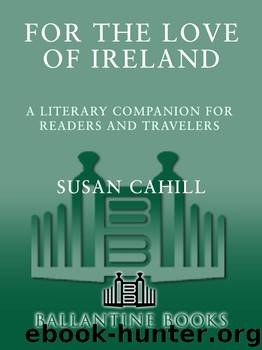For the Love of Ireland by Susan Cahill

Author:Susan Cahill [Cahill, Susan]
Language: eng
Format: epub
ISBN: 978-0-307-77835-2
Publisher: Random House Publishing Group
Published: 2011-02-16T05:00:00+00:00
“The Lament for Art O’Leary,” the dying Gaelic order’s most passionate testament, has also been called an early example of the literature of resistance. All through the hills of West Cork, where for centuries the English were resisted by proud Gaels on foot and on horseback, Eileen maps her memories of the defiant Art O’Leary in the places of his native countryside. “Gugan of the saints” refers to GOUGANE BARRA, a deep black lake walled in on three sides by rocky precipices that turn into waterfalls after rain. Here, where the River Lee begins, St. Finbarr, according to legend, lived a hermit’s life on an island in the lake; then he moved downriver to found the monastery that became Cork City. (Drive west toward Gougane Barra from Ovens, across TOON BRIDGE, through INCHIGEELAGH, around the north side of Lough Allua, heading south through the pass into the scooped-out hollow of Gougane Barra.) Beyond the island is Forest Park, a retreat with waterfalls and walking trails through stands of oak, pine, beech, and ash trees. The stark natural landscape breathes with life, but only in the absence of the weekend busloads of religious pilgrims can Gougane Barra cast its almost mystical spell.
Facing the lake are Cronin’s pleasant pub and a shop where you can buy the new edition of Eric Cross’s The Tailor and Ansty: by reason of its pure authenticity, the book belongs to Eileen O’ Connell’s “Gougane of the saints.”
When Eric Cross came to live here in Gougane Barra, he met the tailor, Timothy Buckley, and his sharp-tongued wife, Ansty or Anastasia. The area was still a Gaeltacht (an Irish-speaking district), and students, including Sean O’Faolain and Frank O’Connor came here and to nearby Ballyvourney to study the Irish language. Cross (and O’Connor) spent many hours in the tailor’s cottage (the third house, painted yellow, on the right going away from the lake) listening to his earthy stories. As Frank O’Connor wrote in his introduction to Cross’s book, to Buckley and his wife, both of whom were bilingual, “sexual relations” were “the most entertaining subject for general conversation”; this was a feature of community life in Irish-speaking Ireland, where nary a puritan roamed. (The tailor’s comment on the rise of fascism in the 1930s was, “There wouldn’t be half this trouble if more people fell to breeding.”) Every night the Buckleys’ hearth was crowded with neighbors and visiting friends, for the tailor was a genuine and much-beloved shanachie (or seanchai), an Irish storyteller who possessed a wide repertoire of folklore. But upon publication of Cross’s book—it’s a collection of the couple’s irreverent stories—the Censorship Board lost its fragile mind. Banning the book as “in its general tendency indecent,” it sent to Gougane Barra three priests who forced the old man, on his knees, to burn his copy of the book on his own hearth. The local people shunned their old friends. Before the book was unbanned, about ten years later, Timothy and Anastasia Buckley were dead. They’re buried in the cemetery down the road opposite St.
Download
This site does not store any files on its server. We only index and link to content provided by other sites. Please contact the content providers to delete copyright contents if any and email us, we'll remove relevant links or contents immediately.
The Tidewater Tales by John Barth(12405)
Kathy Andrews Collection by Kathy Andrews(11343)
Tell Tale: Stories by Jeffrey Archer(8702)
This Is How You Lose Her by Junot Diaz(6463)
The Mistress Wife by Lynne Graham(6254)
The Last Wish (The Witcher Book 1) by Andrzej Sapkowski(5231)
Dancing After Hours by Andre Dubus(5117)
The Sympathizer by Viet Thanh Nguyen(4100)
Maps In A Mirror by Orson Scott Card(3728)
The Secret Wife by Lynne Graham(3669)
Be in a Treehouse by Pete Nelson(3654)
Tangled by Emma Chase(3575)
Ficciones by Jorge Luis Borges(3372)
The House on Mango Street by Sandra Cisneros(3234)
Girls Who Bite by Delilah Devlin(3056)
A Knight of the Seven Kingdoms by George R R Martin(3031)
You Lost Him at Hello by Jess McCann(2871)
MatchUp by Lee Child(2701)
Once Upon a Wedding by Kait Nolan(2617)
